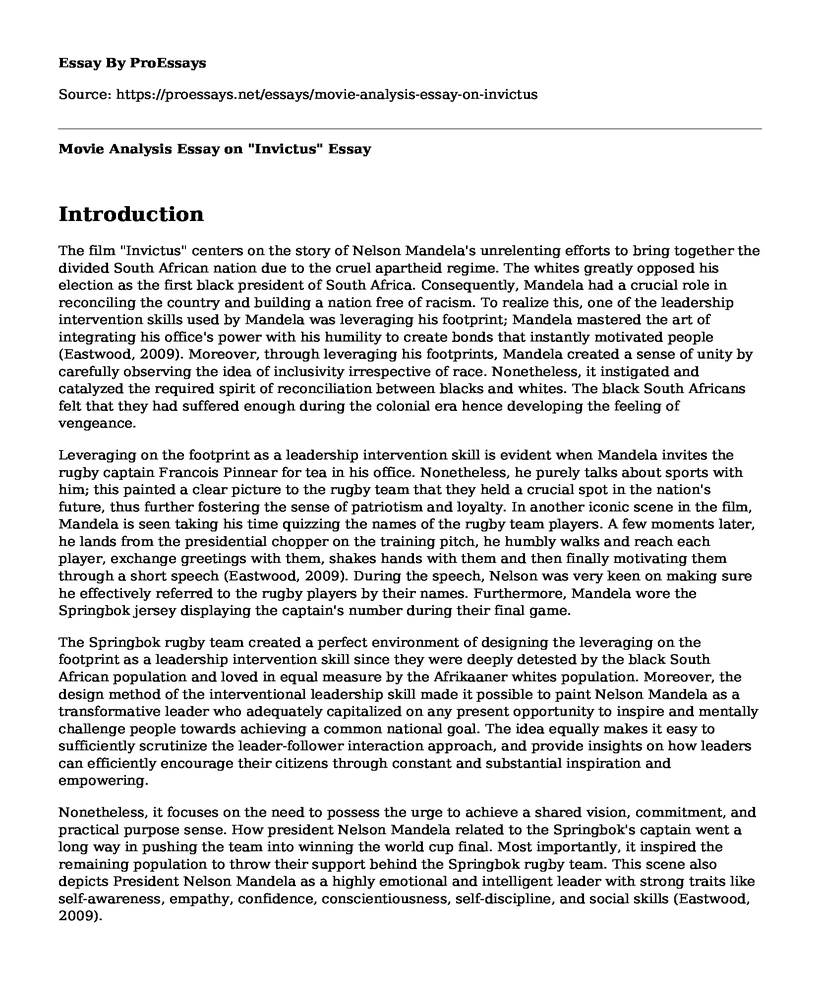Introduction
The film "Invictus" centers on the story of Nelson Mandela's unrelenting efforts to bring together the divided South African nation due to the cruel apartheid regime. The whites greatly opposed his election as the first black president of South Africa. Consequently, Mandela had a crucial role in reconciling the country and building a nation free of racism. To realize this, one of the leadership intervention skills used by Mandela was leveraging his footprint; Mandela mastered the art of integrating his office's power with his humility to create bonds that instantly motivated people (Eastwood, 2009). Moreover, through leveraging his footprints, Mandela created a sense of unity by carefully observing the idea of inclusivity irrespective of race. Nonetheless, it instigated and catalyzed the required spirit of reconciliation between blacks and whites. The black South Africans felt that they had suffered enough during the colonial era hence developing the feeling of vengeance.
Leveraging on the footprint as a leadership intervention skill is evident when Mandela invites the rugby captain Francois Pinnear for tea in his office. Nonetheless, he purely talks about sports with him; this painted a clear picture to the rugby team that they held a crucial spot in the nation's future, thus further fostering the sense of patriotism and loyalty. In another iconic scene in the film, Mandela is seen taking his time quizzing the names of the rugby team players. A few moments later, he lands from the presidential chopper on the training pitch, he humbly walks and reach each player, exchange greetings with them, shakes hands with them and then finally motivating them through a short speech (Eastwood, 2009). During the speech, Nelson was very keen on making sure he effectively referred to the rugby players by their names. Furthermore, Mandela wore the Springbok jersey displaying the captain's number during their final game.
The Springbok rugby team created a perfect environment of designing the leveraging on the footprint as a leadership intervention skill since they were deeply detested by the black South African population and loved in equal measure by the Afrikaaner whites population. Moreover, the design method of the interventional leadership skill made it possible to paint Nelson Mandela as a transformative leader who adequately capitalized on any present opportunity to inspire and mentally challenge people towards achieving a common national goal. The idea equally makes it easy to sufficiently scrutinize the leader-follower interaction approach, and provide insights on how leaders can efficiently encourage their citizens through constant and substantial inspiration and empowering.
Nonetheless, it focuses on the need to possess the urge to achieve a shared vision, commitment, and practical purpose sense. How president Nelson Mandela related to the Springbok's captain went a long way in pushing the team into winning the world cup final. Most importantly, it inspired the remaining population to throw their support behind the Springbok rugby team. This scene also depicts President Nelson Mandela as a highly emotional and intelligent leader with strong traits like self-awareness, empathy, confidence, conscientiousness, self-discipline, and social skills (Eastwood, 2009).
Also, the designing of the scene creates a conducive environment of emphasizing on the point that the best way of leading is leading by setting examples for others to follow, during Mandela's initial meeting within near, he poses the question: How do you lead? Pinnear bases his answer on leading by example.
The context would go hand in hand with capitalizing on backing up essential priorities with bold goals as a leadership intervention skill. I find this leadership intervention impressive because, as the first black South African president, Mandela was faced with two urgent priorities, mollifying the black South African population a the whites and planning an elaborate scheme for the economy to thrive. Nelson knew how much the two correlated, and one couldn't succeed without the other. Therefore, He centered on the goal of winning the rugby world cup as a tool of reconciliation in the nation.
Nonetheless, Mandela makes several business trips in many countries across the globe, intending to convince them to invest in South Africa. It is possible and more effective for a leader to contribute to the intervention of supporting important priorities with goals, having priorities without goals makes a country work on them blindly (Eastwood, 2009).
However, spelling out the goals creates a common basis of reasoning in a nation hence prosperity. If I were the leader, I would develop and instill the idea of self-discipline as a leadership intervention skill since with self-discipline comes the sense of minding one's action, thus encouraging unity.
Conclusion
In conclusion, the movie "Invictus" points out the crucial leadership intervention skills that any leader who is looking forward to being successful in properly running, building, and maintaining unity within the country should imitate. Moreover, the film immensely emphasizes the need to tolerate one another and work towards a common goal of redefining the economic, political, and social aspects of a nation.
References
Eastwood, C. (2009). Invictus: the movie. Warner Bros. USA.
Cite this page
Movie Analysis Essay on "Invictus". (2023, Apr 26). Retrieved from https://proessays.net/essays/movie-analysis-essay-on-invictus
If you are the original author of this essay and no longer wish to have it published on the ProEssays website, please click below to request its removal:
- The Blair Witch Project
- The Life and Works of Chopin Essay
- Short Description of Religion Play
- Political Speeches of of the Greatest Roman Writers and Politician Paper Example
- Film Analysis Essay on Coach Carter
- Filmmaking: Creative Art of Bringing Ideas to Life - Essay Sample
- Essay Sample on Holocaust: Images of Suffering and Cruelty







